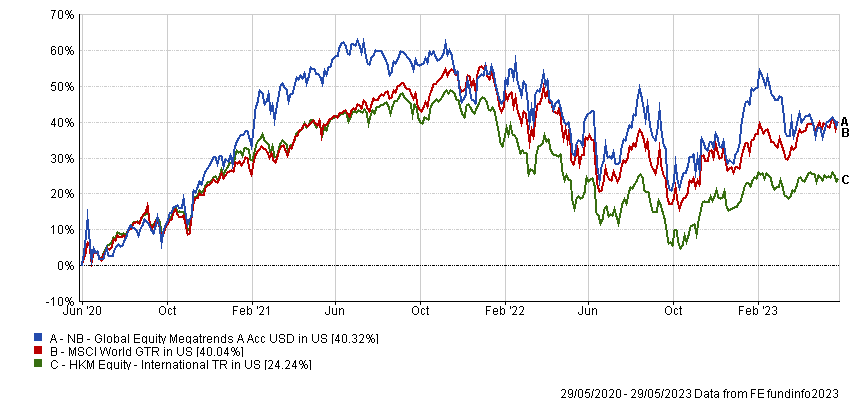While public markets are volatile, investors can use various themes or megatrends as a tool to to identify companies through economic cycles, Sherrell Aston, managing director at Neuberger Berman, told FSA.
Aston co-manages the Neuberger Berman Global Equity Megatrends fund, which was authorised by the Hong Kong Securities and Futures Commission on 5 May for sale to retail investors in the city.
Retail investors can gain access to the A Acc classes in six currencies.
The Global Equity Megatrends fund adopts a three-step approach when selecting stocks to invest in.
The first step is to identify “visible predictable shifts”, which are going to have a lasting impact globally for a minimum of seven to 10 years.
“We spend a lot of time thinking away from Wall Street and the mass media and instead read research papers, go to conferences, speak to industry experts to identify shifts in demographics, shifts in demand for products or services or technologies,” Aston said.
The fund has a low holdings overlap with the MSCI benchmark. For instance, it does not invest in tech names such as Apple and Microsoft, which make up the top two positions of the MSCI World index.
Currently, the fund invests in nine themes, which are evolving global consumer, smart systems, personalisation of media, energy infrastructure, energy efficiency, rising value of water, health and wellbeing, humanisation of pets and education.
In periods of market turbulence such as the Covid disruption in 2020, Aston believes the fund’s focus on long-term trends helped the team to invest through the cycle.
“It was very easy to get distracted and lose one’s way in the greatest period of uncertainty but we stepped back and analysed whether these megatrends will still be relevant at the end of this difficult period.”

Aston believes another advantage of investing in themes is that they naturally evolve as technology and global demand shift.
For instance, the fund invested in oil and gas producers back in the 1990s as they believed energy prices were low.
As valuations went up, the team expanded its investment to infrastructure in the 2000s as they thought energy companies would have to find new energy supply with better equipment and in more remote locations.
After identifying the themes, the fund managers look for unique businesses and those that they believe have a very differentiated product or service.
As alternative energy sources have become increasingly cost competitive and energy efficiency has improved, the fund has moved away from direct investment in oil and gas producers, he added.
“We’re looking for businesses that are enablers of a theme because companies that have unique products or services have a better competitive position and therefore a wider or deeper competitive moat,” said Aston.
“The other thing that we’re looking for in the businesses in which we invest is to identify leaders in the industry because we tend to be owners over many years so we want to have the right partners.”
The last part is to look for companies that have visible, predictable growth and a significant amount of operating leverage that allows them to grow their free cash flow and free cash flow per share.
For example, water used to be a bigger portion of the portfolio, but now only takes up around 2% of the asset allocation as it became a very popular investment area over the past five to seven years.
“There has been a lot of new capital coming into a finite number of listed companies and that has driven the valuations very high.”
“While there are a number of companies that are quite unique with great leadership, they don’t meet the right valuation.”
The share class A was incepted in April 2018 and has posted a three-year cumulative return of 40.32%, compared with the MSCI World index average of 40.04% and the sector average of 24.24%, according to FE fundinfo data.
The fund has a three-year cumulative alpha of 4.23 and volatility of 19.11%.
















